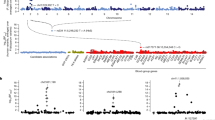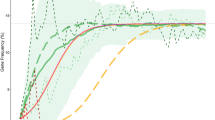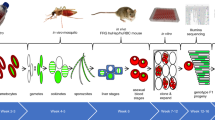Abstract
The global health impact of malaria is enormous, with an estimated 300–500 million clinical cases and 1 million annual deaths1. In humans, initial susceptibility to infection with Plasmodium species, disease severity and ultimate outcome of malaria (self-healing or lethal) are under complex genetic control. Alleles associated with sickle cell anemia, β-thalassemia and deficiency in glucose-6-phosphate dehydrogenase have a protective effect against malaria and may have been retained by positive selection in areas of endemic malaria2. Likewise, genetic variations in erythrocyte antigens and levels of host cytokines affect type and severity of disease3,4. A mouse model of infection with Plasmodium chabaudi was used to study the genetic component of malaria susceptibility. Segregation analyses in informative F2 crosses derived from resistant C57BL/6J and susceptible A/J, C3H and SJL strains using extent of blood stage replication of the parasite and survival as traits mapped three P. chabaudi resistance (Char) loci on chromosomes 9 (Char1), 8 (Char2) and 17 (Char3, MHC-linked)5,6,7. Recombinant congenic strains AcB55 and AcB61 are unusually resistant to malaria despite carrying susceptibility alleles at Char1 and Char2. Malaria resistance in AcB55 and AcB61 is associated with splenomegaly and constitutive reticulocytosis, is inherited in an autosomal recessive fashion and is controlled by a locus on chromosome 3 (Char4)8. Sequencing of candidate genes from the Char4 region identified a loss-of-function mutation (269T→A, resulting in the amino acid substitution I90N) in the pyruvate kinase gene (Pklr) that underlies the malaria resistance in AcB55 and AcB61. These results suggest that pyruvate kinase deficiency may similarly protect humans against malaria.
This is a preview of subscription content, access via your institution
Access options
Subscribe to this journal
Receive 12 print issues and online access
$209.00 per year
only $17.42 per issue
Buy this article
- Purchase on Springer Link
- Instant access to full article PDF
Prices may be subject to local taxes which are calculated during checkout





Similar content being viewed by others
References
Sachs, J. & Malaney, P. The economic and social burden of malaria. Nature 415, 680–685 (2002).
Cooke, G.S. & Hill, A.V. Genetics of susceptibility to human infectious disease. Nat. Rev. Genet. 2, 967–977 (2001).
Weatherall, D.J. & Clegg, J.B. Genetic variability in response to infection: malaria and after. Genes Immun. 3, 331–337 (2002).
Fortin, A., Stevenson, M.M. & Gros, P. Susceptibility to malaria as a complex trait: big pressure from a tiny creature. Hum. Mol. Genet. 11, 2469–2478 (2002).
Foote, S.J. et al. Mouse loci for malaria-induced mortality and the control of parasitaemia. Nat. Genet. 17, 380–381 (1997).
Fortin, A. et al. Genetic control of blood parasitaemia in mouse malaria maps to chromosome 8. Nat. Genet. 17, 382–383 (1997).
Burt, R.A., Baldwin, T.M., Marshall, V.M. & Foote, S.J. Temporal expression of an H2-linked locus in host response to mouse malaria. Immunogenetics 50, 278–285 (1999).
Fortin, A., Stevenson, M.M. & Gros, P. Complex genetic control of susceptibility to malaria in mice. Genes Immun. 3, 177–186 (2002).
Fortin, A. et al. Identification of a new malaria susceptibility locus (Char4) in recombinant congenic strains of mice. Proc. Natl. Acad. Sci. USA 98, 10793–10798 (2001).
Fortin, A. et al. Recombinant congenic strains derived from A/J and C57BL/6J: a tool for genetic dissection of complex traits. Genomics 74, 21–35 (2001).
Jacobasch, G. & Rapoport, S.M. Hemolytic anemias due to erythrocyte enzyme deficiencies. Mol. Aspects Med. 17, 143–170 (1996).
van Solinge, W.W., Kraaijenhagen, R.J., Rijksen, G. & Nielsen, F.C. Novel mutations in the human red cell type pyruvate kinase gene: two promoter mutations in cis, a splice site mutation, a nonsense- and three missense mutations. Blood 90 Supplement, 1197 (1997).
Vidal, S.M., Malo, D., Vogan, K., Skamene, E. & Gros, P. Natural resistance to infection with intracellular parasites: isolation of a candidate for Bcg. Cell 73, 469–485 (1993).
Diez, E. et al. Birc1e is the gene within the Lgn1 locus associated with resistance to Legionella pneumophila. Nat. Genet. 33, 55–60 (2003).
Poltorak, A. et al. Defective LPS signaling in C3H/HeJ and C57BL/10ScCr mice: mutations in Tlr4 gene. Science 282, 2085–2088 (1998).
Lee, S.H. et al. Susceptibility to mouse cytomegalovirus is associated with deletion of an activating natural killer cell receptor of the C-type lectin superfamily. Nat. Genet. 28, 42–45 (2001).
Brown, M.G. et al. Vital involvement of a natural killer cell activation receptor in resistance to viral infection. Science 292, 934–937 (2001).
Vladimirov, V. et al. Different genetic control of cutaneous and visceral disease after Leishmania major infection in mice. Infect. Immun. 71, 2041–2046 (2003).
Kemp, S.J., Iraqi, F., Darvasi, A., Soller, M. & Teale, A.J. Localization of genes controlling resistance to trypanosomiasis in mice. Nat. Genet. 16, 194–196 (1997).
Roth, E. Jr. Plasmodium falciparum carbohydrate metabolism: a connection between host cell and parasite. Blood Cells 16, 453–460 (1990).
Oelshlegel, F.J., Jr., Sander, B.J. & Brewer, G.J. Pyruvate kinase in malaria host-parasite interaction. Nature 255, 345–347 (1975).
Willcox, M. et al. A case-control study in northern Liberia of Plasmodium falciparum malaria in haemoglobin S and beta-thalassaemia traits. Ann. Trop. Med. Parasitol. 77, 239–246 (1983).
Modiano, D. et al. Haemoglobin C protects against clinical Plasmodium falciparum malaria. Nature 414, 305–308 (2001).
Allen, S.J. et al. α-Thalassemia protects children against disease caused by other infections as well as malaria. Proc. Natl. Acad. Sci. USA 94, 14736–14741 (1997).
Zanella, A. & Bianchi, P. Red cell pyruvate kinase deficiency: from genetics to clinical manifestations. Baillieres Best Pract. Res. Clin. Haematol. 13, 57–81 (2000).
Stevenson, M.M., Lyanga, J.J. & Skamene, E. Murine malaria: genetic control of resistance to Plasmodium chabaudi. Infect. Immun. 38, 80–88 (1982).
Sambrook, J.R. & David, W. Extraction, purification, and analysis of mRNA from eukaryotic cells. in Molecular Cloning: A Laboratory Manual vol. 1 (Cold Spring Harbor Laboratory Press, Cold Spring Harbor, New York, 2001).
Tusher, V.G., Tibshirani, R. & Chu, G. Significance analysis of microarrays applied to the ionizing radiation response. Proc. Natl. Acad. Sci. USA 98, 5116–5121 (2001).
Manly, K.F. & Olson, J.M. Overview of QTL mapping software and introduction to map manager QT. Mamm. Genome 10, 327–334 (1999).
Acknowledgements
The authors are indebted to E. Skamene for providing AcB55 and AcB61 recombinant congenic strains and to J. Woodgett for providing spotted cDNA arrays. This work was supported by research grants to P.G. and M.M.S. from the Canadian Institutes of Health Research and from the Canadian Genetic Diseases Network. Expertise in transcriptional profiling was made possible by the Genome Health Initiative of the National Research Council of Canada. P.G. is supported by a salary award from the CIHR (Distinguished Scientist) and by a James McGill Professorship. G.M. is supported by the Maysie MacSporran Award from the Strategic Training Centre in Infectious Diseases and Autoimmunity of the Center for the Study of Host Resistance Group of McGill University.
Author information
Authors and Affiliations
Corresponding author
Ethics declarations
Competing interests
The authors declare no competing financial interests.
Supplementary information
Rights and permissions
About this article
Cite this article
Min-Oo, G., Fortin, A., Tam, MF. et al. Pyruvate kinase deficiency in mice protects against malaria. Nat Genet 35, 357–362 (2003). https://doi.org/10.1038/ng1260
Received:
Accepted:
Published:
Issue Date:
DOI: https://doi.org/10.1038/ng1260
This article is cited by
-
Haematological profile of malaria patients with G6PD and PKLR variants (erythrocytic enzymopathies): a cross-sectional study in Thailand
Malaria Journal (2022)
-
High-carbohydrate diet lacked the potential to ameliorate parasitemia and oxidative stress in mice infected with Plasmodium berghei
Parasitology Research (2022)
-
Role of IRF8 in immune cells functions, protection against infections, and susceptibility to inflammatory diseases
Human Genetics (2020)
-
Enterobacteria and host resistance to infection
Mammalian Genome (2018)
-
Host genetics in malaria: lessons from mouse studies
Mammalian Genome (2018)



